Counterfeit prevention
Pharmaceutical Technology Europe
RFID is viewed by many, including FDA, as a technology with strong potential for carrying the mass serialization data needed to track and trace product and to create pedigree records.
Anticounterfeiting measures ranked as a top-of-mind concern at the Interphex trade show, held earlier this year in New York (NY, USA). This is no surprise because incidents involving counterfeit drugs have spiked in recent years. As a result, manufacturers are taking steps to protect consumers and their brands, and FDA is studying ways to tighten the supply chain.
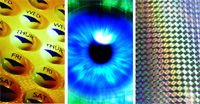
As always, Interphex offered a great chance to study new pharmaceutical packaging concepts and packaging machines, designed to thwart counterfeiting, protect against moisture and oxygen exposure, and improve distribution.
Counterfeit prevention
Anticounterfeiting measures can be divided into two categories: overt and covert. Overt measures include colour-shifting inks, optically variable devices, holograms, thermochromic ink or glue, and tamper-evident security seals. Covert measures include taggants and biomolecular markers, digital watermarks, microprinting, invisible graphics printed with UV-or IR-sensitive ink, anti-theft devices and security substrates. Coding schemes such as mass serialization and consecutive numbering also play a role. Experts recommend using a combination of features to achieve the best protection against counterfeiting.
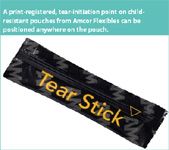
A print-registered, tear-initiation point on child-resistant pouches from Amcor Flexibles can be positioned anywhere on the pouch.
Multilayer approaches. Optically variable devices include an assortment of sophisticated technologies that can be combined to provide multifaceted protection. Some are readily visible, whereas others require a tool such as a magnifier or screened piece of film to detect. Examples include colour effects, minitext, colour flips, hidden information or features, image flips, nanotext or nanoimage, lens effects, rainbows and grayscale images (www.kurz.de).
For labels, a multilayer approach includes adhesive colourants, tinting agents, marker dyes, colour-shifting pigments, magnetic microwire and proprietary markers (www.acucote.com).
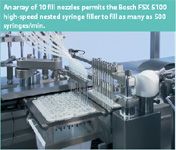
An array of 10 fill nozzles permits the Bosch FSX 5100 high-speed nested syringe filler to fill as many as 500 syringes/min.
Precisely positioned nanoclusters of metal particles on a highly reflective substrate make it possible to produce two-or three-phase colour-shift labels that offer visible and machine-readable colour shifts that are exclusive to a product or company. The metal clusters modify light waves as they enter the film. Optics within the film further alter the light as waves bounce back from a reflective layer (www2.dupont.com).
Forensically invisible markers or taggants that are detectable only by proprietary reading devices can provide multiple levels of security, including basic pass–fail authentication, unique particle-signature identification for item-level recognition and tracking, and additional proprietary levels of security. Built-in safeguards prevent reverse engineering. Taggants can be mixed into almost any packaging material including paper pulp, ink, varnish, laser toner, molten metals and resin, or applied as a coating. Taggants can be detected at levels as low as two parts per million and can add as little as $0.002 to the cost of a package (www.kodak; www.inksure.com; www.rexam.com).
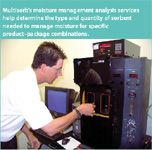
Multisorbôs moisture management analysis services help determine the type and quantity of sorbent needed to manage moisture for specific productâpackage combinations.
Synthesized DNA code fragments can serve as biomolecular markers. Unique markers are created for each customer and are divided into two parts. When the parts are combined, a hybridization reaction assembles the finished, detectable DNA code segment. Field confirmation is performed with a handheld reader that measures a luminescent signal from the DNA (www2.dupont.com).
Another layered approach combines overt, covert and semicovert technologies such as holographic labelling with a destructive adhesive; 14-point security board with fluorescent fibres; infrared inks in pre-determined places on the package; dual-wavelength UV spot varnish; nano-barcode technology or X-ray fluorescing frequency particles in a coating; microtaggants in the glue; radio frequency identification (RFID) tags; and proprietary markers (www.mwvhealthcare.com).
Screened keys laid on top of printed label graphics reveal otherwise invisible watermarks. Multiple images such as a company name, logo and numeric codes can be hidden in the same area to provide a different authentication device for various levels of the supply chain (www.tursso.com).

High-frequency phase-jitter modulation technology developed by Magellan Technology makes it possible for each RFID-tagged item in this tote to be read at line speeds using tags from UPM Raflatac and a tunnel reader from Balogh USA.
Vial coding. Applying permanent serialized codes on glass vials is possible with a laser-based system that transfers pigment from a proprietary ribbon to the glass without damaging its surface. Based on technology developed to mark windshields, the clean room–compatible equipment offers higher resolution than inkjet coding and can reproduce scannable barcodes including 2D matrix codes measuring roughly 1/8 in2 . Codes cannot be scratched off or removed with heat, solvents or acids. The system integrates into existing lines and consists of as many as six stations to apply as many as 400 codes/min (www.atsautomation.com).
Item-level tagging. RFID is viewed by many, including FDA, as a technology with strong potential for carrying the mass serialization data needed to track and trace product and to create pedigree (i.e., chain of custody) records. Several exhibitors demonstrated the technology with various combinations of tags, smart labels, printer–encoders, printer–encoder–applicators, readers, barcodes and software.
Tags carrying serialized item-level codes can be incorporated into standard and multipanel labels, inserts, and folding cartons (www.nosco.com).
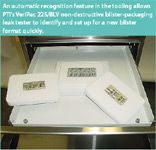
An automatic recognition feature in the tooling allows PTIôs VeriPac 225/BLV non-destructive blister-packaging leak tester to identify and set up for a new blister format quickly.
At least one container supplier can embed an RFID tag in the container base during injection moulding. Embedding the tag reduces chances of damage and improves readability because of consistent orientation and the elimination of tag-to-tag contact. Tag-equipped bottles can be encoded earlier in the packaging process, providing traceability from the filler forward instead of the labeller (www.o-i.com).
The RFID Solutions Centre at this year's show offered a working case-tagging demonstration of the UHF Gen 2 (www.impinj.com), a system capable of encoding, printing and applying smart labels as fast as 40 cases/min. The system also identifies and rejects labels with non-working tags and precisely positioned labels with ±1/16 in. accuracy. An adjustable antenna maximizes tag writing capability (www.printronix.com).
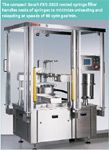
The compact Bosch FXS-2020 nested syringe filler handles nests of syringes to minimize unloading and reloading at speeds of 80 syringes/min.
The centre also offered demonstrations of a 13.56 MHz item-level tagging operation. It featured tags and two readers: one to capture e-pedigree data and one to confirm rejection of product with an unreadable or incorrect tag (www.omronrfid.com; www.ems-rfid.com).
At least one track-and-trace system uses both RFID tags and 2D barcodes for serialized item-level data. RFID tags are applied to items, and a reader captures information and sends it to the controller. The controller in turn activates a laser coder to mark a 2D on the label. Then, bottles are loaded in cases and an RFID case tag is applied. By collecting RFID data as bottles are loaded, item-and case-level data can be linked in the database. Next, cases are stacked on pallets, an RFID pallet tag is prepared and applied, and pallet data are linked to the case-and item-level information (www.dominoamjet.com; www.systech-tips.com).

Laser coder from ATS Automation Tooling Systems and proprietary ribbon from Tesa Tape, Inc produces indelible, high-contrast codes on glass vials.
Personal RFID readers are also becoming a reality with the advent of inexpensive modules that plug into devices such as cell phones, PDAs, or point-of-sale terminals (www.nokia.com).
Security on pills. Using inkjet on individual pills with an alphanumeric or 2D barcode takes serialization a step further. The machine provides positive pill handling and can be built with 4, 8, or 12 lanes. A vision system with a camera for each lane provides 100% inspection. Each lane also has its own reject system, so an individual lane can be halted without stopping the whole machine (www.eamcorp.com). Hardware and software for serialized coding on cartons and non-woven lidstock are also available (www.lucianopackaging.com).
Phase-jitter modulation (PJM). Item-level tagging poses numerous challenges, including 100% reading of multiple tags simultaneously and capturing information from several tags in close proximity to one another and in various orientations. PJM technology, which transmits data as very small phase changes in the powering field, solves both these problems and accelerates tag reading and writing to 600 items/min. Tags have both a high-and low-power mode so that touching tags can be read.
Tags come in a variety of form factors including 25 and 35 mm diameters and three rectangular sizes (16 × 28, 25 × 26 and 76 × 45 mm) in paper-face, wet-inlay, dry-inlay and in-mould configurations. Security features include a unique chip identification that is issued and locked during manufacturing, password-controlled write access modes, and a lock pointer to prevent changes to locked memory cells. A three-axis, eight-channel tunnel reader can write unique 96-bit identification numbers at a rate of 3000 tags/min. Tag reading is even faster at 15000 tags/min (www.magtech.com.au; www.baloghrfid.com; www.upmraflatac.com).
Stability protection
Many drugs must be protected from moisture or oxygen exposure. Small canisters or pouches of a desiccant or oxygen scavenger are usually used for protection. Integral protection can be provided by overmoulding or co-moulding a polymer blend containing an active agent. Capacity can be engineered to maintain a specific relative humidity; absorb moisture, oxygen, odours and gases; provide controlled release of vapours, gases, aromas, flavours, nutrients and biocides; or engineer the transmission rates of thin films (www.o-i.com).
A turnkey approach combines desiccants and scavengers, dispensing equipment, consulting services and technical support to optimize moisture or oxygen control to maximize the shelf life of pharmaceutical and nutraceutical products (www.multisorb.com).
Primary packaging and labelling
A print-registered, tear-initiation point simplifies opening a child-resistant 92–gauge polyester–foil laminate pouch or stick pack and eliminates the need for a tear notch along with attendant material and tooling costs. The proprietary treatment makes it possible to position the easy-tear area anywhere on the pouch or pack and register it with instructional print. The foil laminate may be gravure printed in as many as eight colours (www.amcor-flexibles.com).
A unit-dose delivery system for lotions, creams and ointments features a tiny pouch with a foam applicator and flexographic printing in as many as seven colours plus varnish. A simple squeeze dispenses product to the affected area. The first commercial product, a 0.5 g facial exfoliant, specifies a seven-layer foil laminate, but various laminate structures and foams may be used. Pouches are formed from a single web in 0.5 or 1 g sizes and filled on a custom machine. Frequent in-process testing ensures good seal integrity (www.cardinal.com).
Another small, foil laminate pouch is designed to hold a single thin-film strip medication and is used in a Theraflu product. A chevron-shaped seal area occupies roughly 75% of the pouch area. Beyond the point of the chevron, the remaining pouch material, which is tacked together at the outer corners, serves as pull strips for easy opening. A child-resistant design is also available (www.cardinal.com).
A service to help drug makers optimize blister designs takes into consideration of all variables such as temperatures, pressures and material characteristics, and can perform simulations to identify the packaging choices that are most likely to succeed during stability testing. The analysis not only accelerates the design phase, but may also point out opportunities for barrier and cost reduction. It can also aid in tooling design (www.kpfilms.com).
A new polyvinylidene chloride-coated polyvinyl chloride (PVC) or PVC–polyethylene runs more efficiently on thermoform-fill–seal equipment because of better slip properties. The improved coefficient of friction is supplied by a polymer additive that alters the surface morphology of the coating to reduce surface contact without changing barrier properties. As a result, the film does not block on preheat plates and also denests faster to expedite filling rates for gel caps and other pharmaceuticals. Available in clear and opaque white, the film is compatible with all standard vinyl-compatible lidstocks. Introduced last year in Europe, the film has proven popular with contract packagers (www.kpfilms.com).
A closure that can be programmed for specific dosage regimens facilitates patient compliance by beeping and flashing when a dose is scheduled to be taken. The compliance cap can be produced in various styles and diameters (www.o-i.com).
To meet new prescription drug information requirements, inserts and outserts have expanded in size to accommodate additional information, multiple languages and larger type sizes. To fold these poster-size sheets, an electronically controlled, double-knife system creates as many as 130 panels. For example, a 27 × 39 in. sheet can be folded into 120 panels for a finished size of 2.75 × 3.25 in. by about 0.5 in. thick (www.vijukequip.com).
Equipment
Interphex was the world premier for two nested syringe-filling machines: one low-speed with 2 rotary piston pumps and one high-speed with 10 pumps. The pre-sterilized glass or plastic syringes travel through the machines in their 100-count nests and are filled, inspected and resealed at maximum rates of 80 or 500 syringes/min, respectively. Fill volumes range from 0.5–50 mL. Equipment can be supplied with an integrated isolator and particle-inspection system (www.boschpackaging.com).
A compact monoblock for pilot or biopharmaceutical applications is small enough to move through a standard doorway. Capable of handling 1–100 mL vials, the machine fills and closes as many as 60 containers/min. Tool-free changeover and a starwheel bottle adjustment reduce changeover time to less than 5 min. The $39000 machine can be integrated with an isolator or laminar-flow cabinet. Customers transitioning from a manual process can use the same pump. An onboard help manual resides in the operator interface and includes operating procedures, troubleshooting, and maintenance information in six languages (www.dabrico.com).
Wide-mouth containers with neck diameters ranging from 58–130 mm can be induction sealed at speeds of 200 ft/min without skewing the head to increase sealing dwell time. Solid-state unit eliminates fans, filters, and water (www.cap-sealing.com).
An easy-to-use, non-destructive blister packaging inspector uses vacuum decay and vision imaging to detect and pinpoint the location of package-integrity problems during a 10 s test cycle without stressing seals. Compatible with any combination of printed or unprinted paper, film or foil, the unit detects leaks as small as 5 mm. Changeover occurs in seconds with a quick swap of tooling. An automatic recognition feature on each test tool enables the system to identify the blister format and automatically set test parameters (www.ptiusa.com).
Distribution packaging
Pharmaceutical packagers often specify plastic pallets because of concerns about particulate generation and cleanliness of wooden pallets. In addition, wooden pallets used for export shipments must meet phytosanitary standards. These international rules require wooden pallets to undergo a certified treatment to ensure insects that could damage trees are not transported outside their native areas.
A plastic pallet designed for export applications consists primarily of recycled, high-density polyethylene and provides a dynamic capacity of 1130 kg. Priced at about $12 each, the design of the lightweight, 450 g compression-moulded 48 × 40 in. pallet permits 240 pallets to fit on a truck, thus saving $0.50–1.00/pallet in shipping (www.rehrigpacific.com).
Hallie Forcinio is Pharmaceutical Technology's packaging editor. This article was first published in Pharm. Technol. 30(6), 36–42 (2006).

INTERPHEX 2025: Use of Walk-In Chambers for Bio/Pharma Development and Manufacturing
April 2nd 2025Sitting down with the PharmTech Group at INTERPHEX 2025, Christopher Murphy, director of Global Business Development and Service Customer Support at Environmental Specialties, discusses the design and critical role of walk-in chambers in the bio/pharmaceutical industry.
Drug Solutions Podcast: A Closer Look at mRNA in Oncology and Vaccines
April 30th 2024In this episode fo the Drug Solutions Podcast, etherna’s vice-president of Technology and Innovation, Stefaan De Koker, discusses the merits and challenges of using mRNA as the foundation for therapeutics in oncology as well as for vaccines.